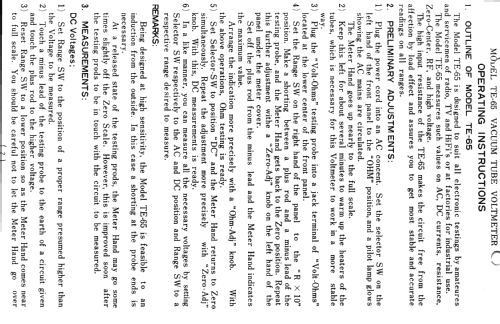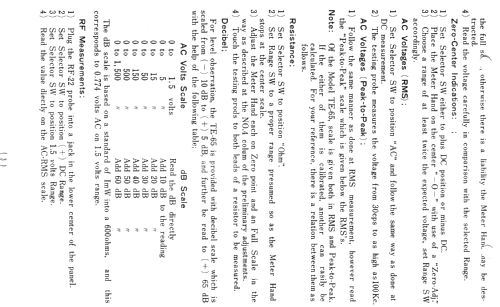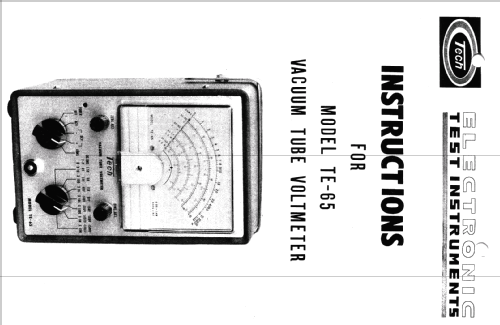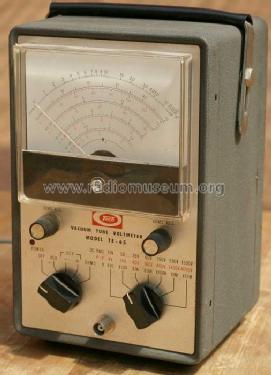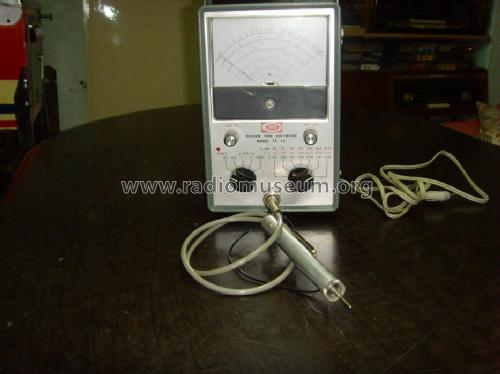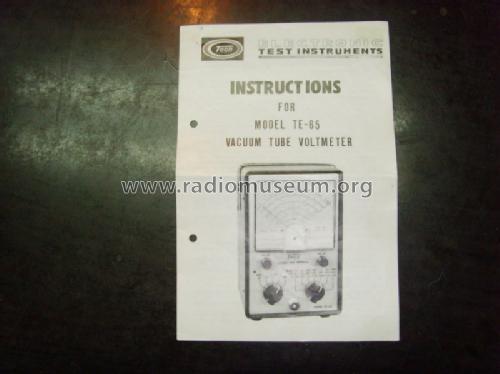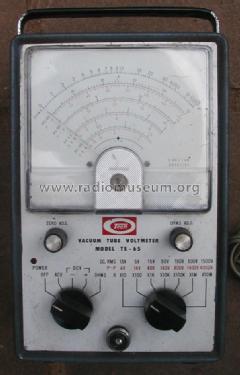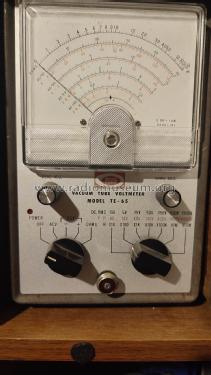RMSV-Meter TE-65
Tech Instruments Co. Ltd.; Tokyo
- País
- Japon
- Fabricante / Marca
- Tech Instruments Co. Ltd.; Tokyo
- Año
- 1970–1972 ??
- Categoría
- Aparato de medida y servicio (Equipo de laboratorio).
- Radiomuseum.org ID
- 99728
Haga clic en la miniatura esquemática para solicitarlo como documento gratuito.
- Numero de valvulas
- 2
- Gama de ondas
- - no hay
- Tensión de funcionamiento
- Red: Corriente alterna (CA, Inglés = AC) / 220-240 Volt
- Altavoz
- - - No hay salida de sonido.
- Material
- Metálico
- de Radiomuseum.org
- Modelo: RMSV-Meter TE-65 - Tech Instruments Co. Ltd.;
- Forma
- Sobremesa alto de forma simple.
- Ancho, altura, profundidad
- 140 x 215 x 150 mm / 5.5 x 8.5 x 5.9 inch
- Anotaciones
-
- Technische Daten:
- Innenwiderstand
- 11MΩ auf allen Bereichen
- Gleichspannungsmeßbereiche
- 1,5/5/15/50/150/500/1500V
- Wechselspannungsmeßbereiche
- Veff: 1,5/5/15/50/150/500/1500V
- Vss: 1,4/4/14/40/140/400/1400/4000V
- Widerstandsmeßbereiche
- 10/100/1k/10k/1M/10MΩ
- dB:
- -10 bis +65dB (0dB=1mW an 600Ω)
- Innenwiderstand
- Normalzubehör
- Gleichspannungsprüfspitze
- 2 Meßleitungen
- 1 Monozelle 1,5V
- 1 Bedienungsanleitung
- Sonderzubehör
- HV-Prüfspitze 30kV (28,50 DM)
- HF-Tastkopf 250MHz (26 DM)
Ähnlich oder baugleich mit Conrad CTR Röhrenvoltmeter HRV-240
The Eico 232 peak to peak VTVM seems to be an identical design supplied as a kit, thus had a detailed schematic.
Rated for up to 60 MHz without a special probe.
- Technische Daten:
- Peso neto
- 2.5 kg / 5 lb 8.1 oz (5.507 lb)
- Precio durante el primer año
- 178.50 DM
- Documentación / Esquemas (1)
- -- Original-techn. papers. (Technik-Versand KG, Katalog Nr. 23, 1972)
- Autor
- Modelo creado por Jos Lauth. Ver en "Modificar Ficha" los participantes posteriores.
- Otros modelos
-
Donde encontrará 18 modelos, 17 con imágenes y 9 con esquemas.
Ir al listado general de Tech Instruments Co. Ltd.; Tokyo
Colecciones
El modelo RMSV-Meter es parte de las colecciones de los siguientes miembros.
Contribuciones en el Foro acerca de este modelo: Tech Instruments Co.: RMSV-Meter TE-65
Hilos: 1 | Mensajes: 4
I noticed that the Ohms range was erratic. Many or most of the schematics don't show it, but the 1.5V nominal D Cell (mono cell) is actually only connected when the left switch is at ohms.
Also the battery will run down quickly if there is a short on the probe leads on the low ohms range and on Ohms.
The resistance in series with the battery to test lead is low on low ranges:
9.7
90 + 9.7
900 + 90 + 9.7
9K + 900 + 90 + 9.7
Etc.
So if a voltage is on the test input then there can be considerable input current if the left switch is at Ohms (battery connected).
Naturally the 9.7, 90 and 900 resistors were a bit cooked. The 9.7 seems to have been 12 Ohms, it read 4 Ohms. Perhaps it had a parallel resistor. The 90 and 900 were both pairs of resistors.
So on the lowest range the battery supplies between 110mA and 160mA depend on if near exhausted or new. Obviously the other ranges progressively use about 1/10th each time.
As the valves take 600mA and the 6.3V winding is earthed at one side, it might be feasible to use a 1.25V to 1.6V regulator based on an LM317 (minimum is 1.2V approx.). However that would be easily damaged on the low resistance ranges by an in circuit voltage.
Perhaps the safer approach is simply to add a 250mA fuse to protect the resistors and battery on the low resistance ranges. An LM317 could have a reverse rectifier across it, but unlike a battery which can sink current long enough for the fuse to blow, there is nothing to sink current from the external source to blow the fuse.
Michael Watterson, 07.Jun.24

